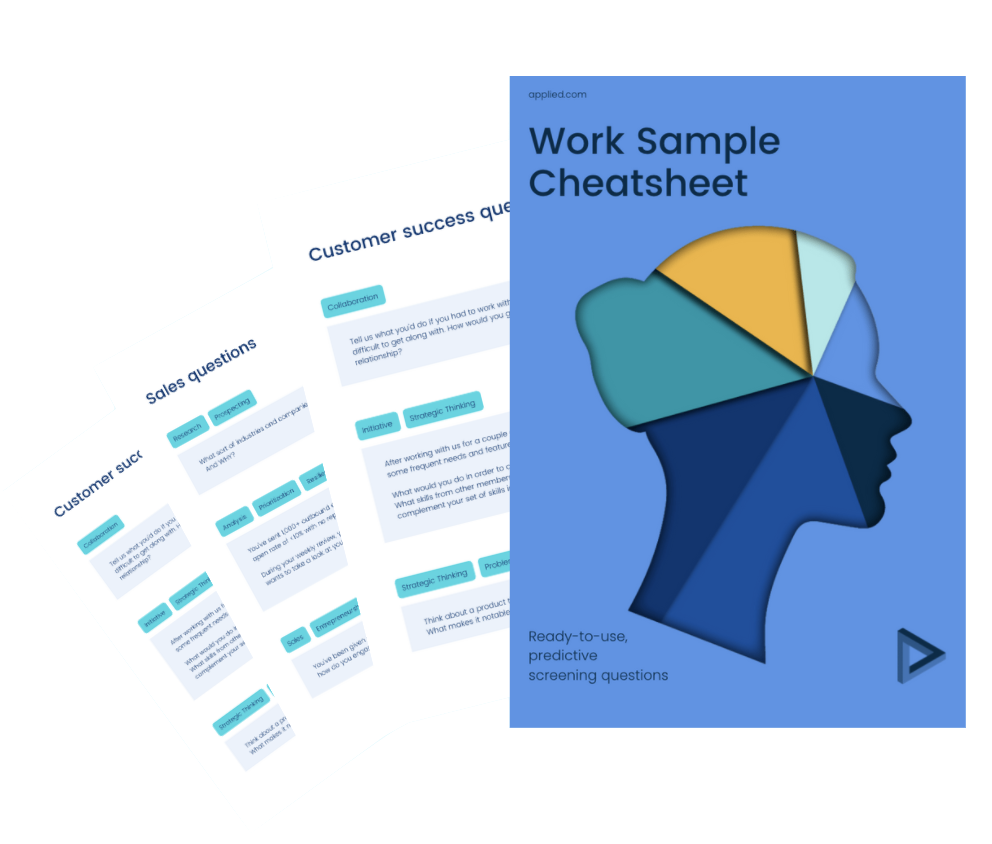
If you’re reading this, chances are you’ve looked at your fair share of CVs… or at least have one of your own.
CVs may be a staple of your average hiring process, but that doesn’t mean they’re any good.
In fact, CVs have been proven to be completely ineffective at finding the best candidates.
They’re not predictive of candidate’s skills, which means that employers make hiring decisions based on biases, rather than actual ability.
Perhaps one of the reasons these outdated behemoths are still a staple of recruitment is that nobody has ever suggested a decent alternative.
If you’re not going to use CVs, what the hell can you use?
Well, there is a better way of sifting candidates…
Bring your interview questions forward to the screening stage
No hirer would want to miss out on interviewing top talent, but with CVs, that’s exactly what happens… they’ll most likely be sitting in the ‘no’ pile.
*This isn’t just speculation - our research has found that we’ve already helped hire 1,865 people that wouldn’t have been hired through the CV process.
You can only bring a handful of candidates in to be interviewed. How do you decide who to interview?
Interviews (at least should be) the stage where you get a real insight into how candidates think. So, we went ahead and put the CV-style questions right at the start of the process.
These questions give you a chance to assess the actual skills you’re looking for, without trying to work out if someone would be suitable - let them show you instead!
Test the relevant skills with work sample questions
These interview-style questions are called work samples. They’re your best bet for saying sayonara to CVs.
Work sample questions are designed to test specific skills needed for a given role.
In short, they work by asking role-related, situational questions, each assessing a necessary skill. These could range from soft skills like passion, to technical capabilities like SQL.
They’re designed to pose realistic problems or scenarios that candidates could encounter in the job they’re applying for.
By using these ‘real’ scenarios, hirers can see how candidates would perform in the role, and irrelevant, biased factors (such as education and experience) are removed from the decision making process.
At Applied, anyone who applied to work with us has to answer work sample questions, which are scored in an objective and consistent way.
We get that coming up with interview questions can be a pain in the backside - but creating work sample questions is fairly straightforward:
4 steps to creating work sample questions
- Decide on the skills you want to test.
- Think of real situations that the candidate would come across in the job (maybe they’ve already happened).
- Pose questions hypothetically e.g. what would you do…
- Give yourself scoring criteria so you can stay objective.
Decide on the skills needed for the role
You’ll want to start by defining 6-8 essential skills for the role you’re hiring for.
These can be a mix of technical skills and soft skills (think time management, teamwork, etc).
We recommend having a mix of these, although some roles will naturally require more technical skills by nature.
Although this part might seem skip-able, it’s essential if you want to hire the best person for the job. Once you know what good looks like, you’ll be able to identify them objectively.
Think of real situations to turn into hypothetical questions
Now, you need to think of 3-5 questions to test these skills.
If you’re doing it right, this shouldn’t require too much thinking.
Ask yourself: what scenarios would this person face day-to-day in the role? If this role isn’t a brand new one, then you can recall any situations that actually did happen.
By using real-life scenarios to test candidates, you get to see how they would actually behave and react if they got the job.
Think of a real-life scenario that could (or already has) come up on the job that would require each of the skills.
Once you’ve thought of a few suitable scenarios, frame them as questions, as if you’re asking what candidates would do if they were to get the job.
To give you an idea of what these look like in practice, take a look at some of the work sample questions we used when recently hiring for a Client Growth Manager…
We asked:
"Why Applied? Why Now? Why a start-up?"
This is to test the candidate’s passion for what we do.
And we also asked the following question to test their strategic thinking and analytical ability:
“You have received a lead from the Marketing Department at Applied. They have arranged an initial introductory call for you which will last about 30 minutes. How would structure the call and what would success look like? What would you do to follow up afterward?”
This question faces candidates with a task that they would actually be doing should they be hired. Not only does this allow us to test the right skills and see how they work, but gives the candidates a feel for what they’d actually be doing.
When candidates are required to engage with what you do and the role they’d be doing, you’ll likely suffer fewer drop-offs and see candidates being more clued-up and passionate by the time the interviews come around.Pose questions hypothetically

Pose questions hypothetically
Frame the questions as if you’re asking what candidates would do hypothetically.
‘Tell me a time when’ questions may be your go-to, but they don’t reveal a candidate’s true potential.
Just because someone hasn’t encountered a specific situation before, this doesn’t mean they wouldn’t be the best person to deal with it. You’re looking at a candidate’s potential, not what they’ve done already.
If they have handled a given situation in their past and actually learned from their past experience, then this will be reflected in their answer.
Give yourself scoring criteria
If you want to score answers objectively (which you should), you’ll need scoring criteria.
This doesn’t need to be super detailed. Just write down (or type out) what a poor, no effort 1-star answer would look like and what someone would have to do to achieve a 5-star answer.
Once you know what good actually looks like, it’ll be much easier to spot talented candidates. You’ll also be able to tell which questions are the most effective and which aren’t helping to thin the herd.
Your most valuable questions will be the ones that result in the most polarising scores. If most candidates either do well or poorly on one question, then you might want to give it a miss.
The result: less time spent interviewing unsuitable candidates
With the CV sift, there’s a good chance you’re eliminating the best candidate for the job before even getting to speak to them. That means you’re more likely to be interviewing candidates who aren’t appropriate.
When you think about it, the onus is on you to scan CVs and work out if the candidate is suitable. This is because their CV is a one-size-fits-all bait - being dipping into a bunch of ponds to see if anything bites.
With work sample questions, it's down to the candidate to show you that they’re the best person for that specific job and demonstrate their skills.
If you’re scoring objectively, you’ll have a clear ranking of candidates before bringing anyone through to interview. So, the people you do decide to speak to will have already proven that they know their stuff.
Give candidates a fair chance
Nobody gets instantly disqualified because they don’t have the ‘right experience’. Sure, it may well turn out that the best candidates for a particular role have a relevant background - but that isn’t always the case. Some of our tech team here at Applied actually came from weird and wonderful backgrounds that had nothing to do with developing!
The best person for the job could come with a fresh, outsider perspective, but if you’re using CVs, they’d be relegated straight to the ‘no’ pile.
If you want to completely eliminate unconscious bias from your hiring process, just using work samples won’t quite cut it.
There’s still plenty of ordering effects and biases at play. Did you know that we make harsher decisions closer to lunchtime? We built our hiring platform to eliminate bias using behavioural science research. Curious? Feel free to book in a demo or check out some of our resources.


.png)

.png)

